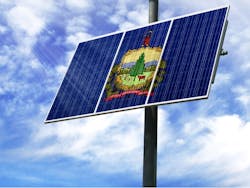Homes to Sell Renewable Energy to Businesses in Vermont’s First of a Kind Local Energy Marketplace
The Holy Grail of local energy lies in the ability of customers to sell to one another. LO3 Energy, a leader in the quest, took a big step today with a program that lets homeowners sell renewables directly to businesses served by Vermont utility Green Mountain Power.
Called Vermont Green, the pilot project also looks to solve some haunting industry issues, among them achieving 100% renewable energy, replacing net metering, and simplifying green energy purchases.
“This is a landmark moment for energy in the US as it is the first time a community scale local energy market has been developed, regulated and commercially operated,” said Lawrence Orsini, CEO of LO3 Energy, a software company based in Brooklyn, New York.
As described by the two companies, the process is market driven, app-based and simple for participants. The transactions occur between businesses that want more renewable energy and homeowners with solar panels that are willing to sell their output.
The test program begins December 2 and will be open initially to 200 customers — fifty businesses and 150 households. The participants will trade a kind of local renewable energy credit (REC) that the utility is calling Vermont Green Attributes.
How it works
Via an auction platform created by LO3 Energy, the business indicates the maximum amount it’s willing to pay for the solar energy. The platform conducts the auction, settled once per day for renewable attributes created the previous day. The trades are transparent to the participants.
Green Mountain Power handles the billing and compenates the households. The utility also creates and hosts the marketplace and covers its costs by way of a 5% transaction fee assessed on the seller. The program costs are “modest” and in the first year are about $41,001, largely related to the expense of software development. After that, the costs mostly come from hosting the market, according to the filing.
The program is expected to result in about 500 MWh in trades per year. If the households can not provide enough renewable energy for the businesses, the utility will make up the difference from its wind and ‘Cow Power’ assets.
Vermont electric customers already get a lot of their power from green sources — about 60%. So the pilot is geared toward companies trying to move toward 100% renewable energy and helps them do so without the complexity of power purchase agreement.
“We have heard anecdotally from some businesses that current REC options are not appealing for various reasons, including the inflexibility of entering long-term agreements, the potential hassle of locating and working with trusted brokers, and the question of location/origin related to the RECs,” said Green Mountain Power in a report about the pilot filed with the Vermont Public Utility Commission.
Vermont Green overcomes these problems by providing businesses with certainty as to source of their energy, said Scott Kessler, director of business development for LO3 Energy.
“This is an offering provided by their utility, so there is a little more trust there. And also they are able to procure green energy from local residential producers. So there a little bit of a circular economy concept going on too,” said Kessler in an interview today with Microgrid Knowledge.
In its November 18 filing to state regulators, Green Mountain Power explained that the trades will happen in near-real time, making them markedly differently from conventional REC sales, which typically happen on a six-month time lag.
Uses LO3 Energy’s blockchain tech
Green Mountain Power selected LO3 Energy from among six transactive energy vendors who participated in a request for proposals.
LO3 Energy is perhaps best known for its blockchain technology being developed at the Brooklyn Microgrid. The Vermont project takes advantage of this expertise.
In this case, the blockchain is a log of transactions occurring in the marketplace. Blockchain technology is well-suited for verifying “the chain of custody of renewable energy attributes,” said Green Mountain Power in the PUC filing. It helps assure that renewable attributes are not double counted.
The partners see the pilot as the first step in creating much more robust local energy markets. Green Mountain Power say the platform could form a “backbone” for local energy transactions involving energy storage, electric vehicle chargers, and thermostatically-controlled loads or carbon offsets.
The utility also envisions bundling the product “along with separate offerings such as electric vehicle car charging to help customers drive even cleaner,” according to the filing. “Lastly, LO3 is currently developing features that would allow buyers to specify a town or even the exact seller to purchase from, helping to strengthen connections and economic activity within local communities.”
If successful, Vermont Green could offer an alternative to net metering, which has become a source of strife between utilities and the solar industry in parts of the US. Vermont Green offers an alternative way for households to earn revenue from selling solar that doesn’t require payment by the utility.
By anweber/Shutterstock
What’s ahead
Kessler sees the approach eventually dovetailing with microgrids and other non-wires alternatives, as locational pricing becomes integrated into the marketplace, opening up the opportunity for accurately valuing of the assets.
“So there is no immediate connection today. But as these things evolve, we very much do see an overlap,” he said.
Green Mountain Power is a utility already known for its innovation in microgrids and battery storage. The utility hopes to use Vermont Green to acellerate demand for renewables and further its goal of becoming 100% renewable by 2030, and 100% carbon free by 2025.
“This is a whole new way to think about local, renewable energy. Vermonters generating it on their rooftops can now sell it to businesses right in their own communities,” said Josh Castonguay, who leads the utility’s Innovation Team. “If you’re a company who wants your product to be made with renewable power, you can do that. While you’re brewing that special beer, or building that line of furniture, you can buy the amount of power you need with the app.”
Track news about innovations in local energy. Subscribe to the free Microgrid Knowledge newsletter.
About the Author
Elisa Wood
Editor-in-Chief
Elisa Wood is the editor and founder of EnergyChangemakers.com. She is co-founder and former editor of Microgrid Knowledge.

